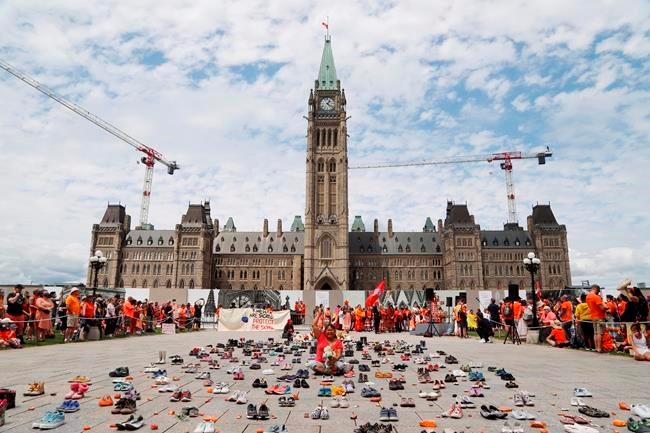They were honoured with thousands of tiny shoes lined up in front of churches and government buildings across the country following the disturbing discovery of unmarked graves at the site of a former residential school in British Columbia.
The children who didn’t come home from residential schools have been chosen in the annual Canadian Press survey of editors across the country as newsmaker of the year.
“People thought about their own children and their own grandchildren,” said Murray Sinclair, a retired senator and the chairman of the Truth and Reconciliation Commission, which heard from residential school survivors and their families about the lasting trauma on generations of Indigenous people.
“They asked themselves the questions: 'Why did this happen?’ and ‘What if it were my kids?’”
The children received 56 out of 88 votes from editors. Health workers, who continued to provide front-line care through labour shortages and pressures of the COVID-19 pandemic, ranked second with 14 votes. Michael Kovrig and Michael Spavor, two Canadians released after nearly three years in a Chinese prison, came in third with nine votes.
The CP newsmaker of the year is typically an individual. Former prime minister Pierre Trudeau was named newsmaker of the year nine times in the late 1960s and '70s. Occasionally, however, groups of individuals have been selected — front-line workers in 2020, the Humboldt Broncos hockey team in 2018, the Canadian soldier in 2006. The discovery of the children's unmarked graves was also selected by editors as news story of the year in the same Canadian Press survey.
“Canada couldn't turn its gaze away from the horrors of the residential school system any longer. Not after these graves were uncovered,” wrote Jodi Isenberg, a senior editor with the Toronto Star.
Canadians were forced to confront the country’s history in May when the Tk’emlups te Secwepemc First Nation revealed that ground-penetrating radar had detected what were believed to be the remains of 215 Indigenous children at the former Kamloops Indian Residential School site in B.C.
Anger and grief rippled across the country. There were rallies and ceremonies. Statues of figures seen as representing colonial forces behind the schools were toppled.
In the months that followed, more graves were found at other former residential school sites. Governments committed money to finding and commemorating more graves and the country marked its first National Day for Truth and Reconciliation in September.
An estimated 150,000 Indigenous children were forced to attend residential schools over a century. The Truth and Reconciliation Commission detailed mistreatment at the schools, including emotional, physical and sexual abuse of children. Its final report included findings of at least 4,100 deaths and an unknown number of unmarked graves.
Sinclair said many Canadians were aware on an intellectual level about what happened at the schools. But, he said, the unmarked graves “brought it home to the heart.”
He said survivors of residential schools have told him they feel as if the stories they've been telling all their lives have been heard and, finally, believed.
Sinclair said the discovery has had a substantial effect on the discourse around Indigenous issues and is changing the way people understand Canada's history. Many are wondering what the graves say about us as a society and how Indigenous people are treated now, he added.
“What does that say about us today that we still see this as an Indigenous issue, not a non-Indigenous issue?”
Brandon Sun managing editor Matt Goerzen wrote that it was long past time for the nation to reassess its view on Canada's history and the current relationship with Indigenous people.
“This year, the people who made the biggest news were sadly not around to know how much their country mourns them,” wrote Eileen Bell, news manager for 630 CHED/Global News Radio in Edmonton.
The children who did not return home stirred the country in ways not seen before, said Stephanie Scott, executive director of the National Centre for Truth and Reconciliation in Winnipeg. That impact must now turn into action, she said.
"The horrifying truth of a genocide of Indigenous peoples in this country will continue to be revealed for many, many years," Scott said in an emailed statement.
"I’m hopeful we may one day have justice for all our children to move forward towards reconciliation."
This report by The Canadian Press was first published Dec. 15, 2021.
Kelly Geraldine Malone, The Canadian Press



